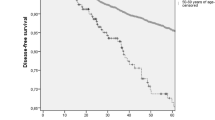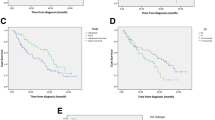Abstract
Purpose
The objective of the study is to investigate recent changes in patient characteristics and treatment procedures of young breast cancer patients over the last 10 years in Germany.
Methods
The study describes the data of 518 patients who were treated adjuvantly between 2008 and 2011 and participated in a resident mother–child program for rehabilitation (cohort II). The data includes TNM-categories, biology of tumor and therapies. This population is compared to a cohort of 535 patients, who were treated between 2002 and 2006 (cohort I). Characteristics and treatment of cohort II are compared with a normally age distributed cohort.
Results
51.5 % of the patients in cohort II were diagnosed with tumor category pT1, 36.9 % pT2, 4.4 % pT3 and 1.2 % pT4. 3.3 % had merely DCIS. 58.1 % of the patients were pN0, 28.4 % pN1 and 13.5 % had a more intense manifestation of lymph nodes. 45.8 % of the tumors showed a grading classified as G3, 69.3 % were estrogen and progesterone hormone receptor positive and 21.8 % Her2 positive. 24.5 % of the examined patients showed a triple negative carcinoma. 66.2 % of the patients with pT1 or pT2 underwent breast-conserving surgery. Overall 19.2 % of the women received mastectomy only and 17.4 % received mastectomy with subsequent reconstruction. 98.6 % of the patients received axillary surgery, 87.6 % chemotherapy. Overall, 21.0 % of the patients received their chemotherapy in connection with clinical studies. 88.0 % of the patients with hormone receptor positive tumors received endocrine therapy, 25.5 % of them with GnRH-analogs. In comparison with cohort I the tumors in cohort II were detected with a higher proportion of negative lymph nodes (48.8 %/58.1 %, p = 0.008) and G1 grading (4.9/5.6 %, p = 0.001). On the other hand the percentage of triple negative tumors increased from 21.0 % to 24.5 % (p = 0.018). Operative therapy has adjusted to a more moderate way. Breast-conserving therapy with pT1 and pT2 increases from 57.3 % to 66.2 % (p = 0.006), sentinel lymph node biopsy only from 24.5 % to 47.5 % (p‹0.001) over the years. The percentages of chemotherapy, radiation, endocrine therapy and antibody therapy with positive receptor have stayed stable over the last decade. Comparing cohort II with a normally age distributed group (DMP II 2007–2009) the young patients have still a much lower portion of negative lymph nodes (58.1 %/67.9 %) and positive hormone receptor status (69.3 %/85.1 %). The percentage of a high grading G3 is 45.8 % in cohort II versus 24.7 % in DMP II. The portion of breast-conserving therapy with pT1 is with 68.9 versus 82.2 % still comparatively low. Young patients received more axillary surgery (98.6 %/81.5 %) but less endocrine therapy with hormone receptor positive tumors (93.3 %/94.7 %).
Conclusion
Young breast cancer patients in Germany can still be regarded as a special group. Although tumors are now more often detected before reaching the lymph nodes than 10 years ago, an even bigger percentage is triple negative. Operative treatment has improved to a less aggressive way. Still operative and medical treatments have to be chosen after very careful evaluation.
Similar content being viewed by others
References
Robert Koch-Institut (Hrsg.) und Gesellschaft der epidemiologischen Krebsregister in Deutschland (Hrsg.) (2012): Krebs in Deutschland 2007/2008. 8. Ausgabe, Berlin
Katalinic A, Lemmer A, Zawinell A, Rawal R, Waldmann A (2009) Trends in hormone therapy and breast cancer incidence–results from the german network of cancer registries. Pathobiol 76:90–97
DeMichele A, Putt M, Zhang Y, Glick JH, Norman S (2003) Older age predicts a decline in adjuvant chemotherapy recommendations for patients with breast carcinoma: evidence from a tertiary care cohort of chemotherapy-eligible patients. Cancer 97:2150–2159
Kosiak B, Sangl J, Correa-de-Araujo R (2006) Quality of health care: what do we know? Women Health Issues 16:89–99
Banz-Jansen C, Heinrichs A, Hedderich M, Waldmann A, Dittmer C, Wedel B, Mebes I, Diedrich K, Fischer D (2012) Characteristics, therapy of premenopausal patients with early-onset breast cancer in Germany. Arch Gynecol Obstet 286(2):489–493
Disease-Management-Programme in Nordrhein Qualitätsbericht (2011) http://www.kvno.de/downloads/quali/qualbe-dmp11.pdf
Robles-Castillo J, Ruvalcaba-Limon E, Maffuz A, Rodriguez-Cuevas S (2011) Breast cancer in Mexican women under 40. Ginecol Obstet Mex 79(8):482–488
Kheirelseid EA H, Boggs JM, Curran C, Glynn RW, Dooley C, Sweeney KJ, Kerin MJ (2011) Younger age as a prognostic indicator in breast cancer: a cohort study. BMC Cancer 11:283
Tarone RE (2006) Breast cancer trends among young women in the United States. Epidemiology 17(5):588–590
Altekruse SF, Kosary CL, Krapcho M. (2010) SEER Cancer Statistics Review 1975–2007. In: Bethesda KD (eds) National Cancer Institute, based on November 2009 SEER data submissions, posted to the SEER web site, 2010. http://seer.cancer.gov/csr/1975_2007/, accessed November 5, 2010
Gonzales-Angulo AM, Broglio K, Kau SW, Eralp Y, Erlichman J, Valero V, Theriault R, Booser D, Buzdar AU, Hortobagyi GN, Arun B (2005) Women age < or =35 years with primary breast carcinoma: disease features at presentation. Cancer 103(12):2466–2472
Rapiti E, Fioretta G, Verkooijen HM, Vlastos G, Schäfer P, Sappino AP, Kurtz J, Neyroud-Caspar I, Bouchardy C (2005) Survival of young and older breast cancer patients in Geneva from 1990 to 2001. Eur J Cancer 41(10):1446–1452
Loibl S, Amant F, Kaufmann M, Ring A, Han S, Giermek J, Fehm T, Bontenbal M, Heinrigs M, Lenhard M, Scherr I, Mehta K, von Minckwitz G (2010) Patients with breast cancer during pregnancy-results from a prospective and retrospective registry (GBG20/BIG02–03). Cancer Res 70(24 Suppl):S2–S6
Colleoni M, Rormensz N, Robertson C, Orlando L, Viale G, Renne G, Luini A, Veronesi P, Intra M, Orecchia R, Catalano G, Galimberti V, Nolé F, Martinelli G, Goldhirsch A (2002) Very young women (‹35 years) with operable breast cancer: features of disease presentation. Ann Oncol 13:273–279
El-Saghir NS, Seoud M, Khalil MK, Charafeddine M, Salem ZK, Geara FB, Shamseddine AI (2006) Effects of young age at presentation on survival in breast cancer. BMC Cancer 6:194
Elkum N, Dermime S, Ajarim D, Al-Zahrani A, Alsayed A, Tulbah A, Al Malik O, Alshabanah M, Ezzat A, Al-Tweigeri T (2007) Being 40 or younger is an independent risk factor for relapse in operable breast cancer patients: the Saudi Arabia experience. BMC Cancer 7:222
O’Shaughnessy J, Osborne C, Pippen JE, Yoffe M, Patt D, Rocha C, Koo IC, Sherman BM, Bradley C (2011) Iniparib plus chemotherapy in metastatic triple-negative breast cancer. N Engl J Med 364(3):205–214
de Bock GH, van der Hage JA, Putter H, Bonnema J, Bartelink H, van de Velde CJ (2006) Isolated loco-regional recurrence of breast cancer is more common in young patients and following breast conserving therapy: long-term results of European organisation for research and treatment of cancer studies. Eur J Cancer 42(3):351–356
Han W, Kim SW, Park IA, Kang D, Kim SW, Youn YK, Oh SK, Choe KJ, Noh DY (2004) Young age: an independent risk factor for disease-free survival in women with operable breast cancer. BMC Cancer 4:82
Acknowledgments
We thank “Klinik Ostseedeich” in Groemitz and especially the patients for their cooperation.
Conflict of interest
We declare that we have no conflict of interest.
Author information
Authors and Affiliations
Corresponding author
Rights and permissions
About this article
Cite this article
Banz-Jansen, C., Heinrichs, A., Hedderich, M. et al. Are there changes in characteristics and therapy of young patients with early-onset breast cancer in Germany over the last decade?. Arch Gynecol Obstet 288, 379–383 (2013). https://doi.org/10.1007/s00404-013-2738-7
Received:
Accepted:
Published:
Issue Date:
DOI: https://doi.org/10.1007/s00404-013-2738-7




